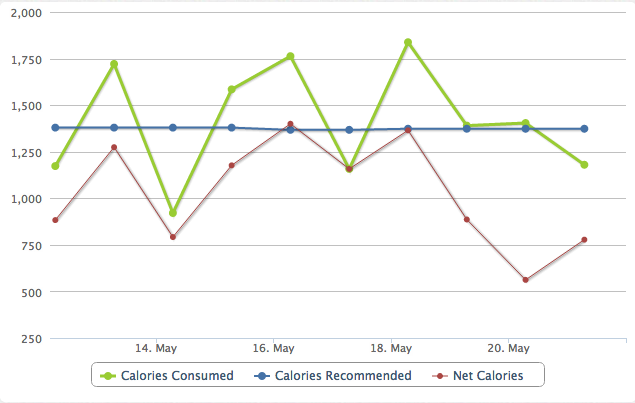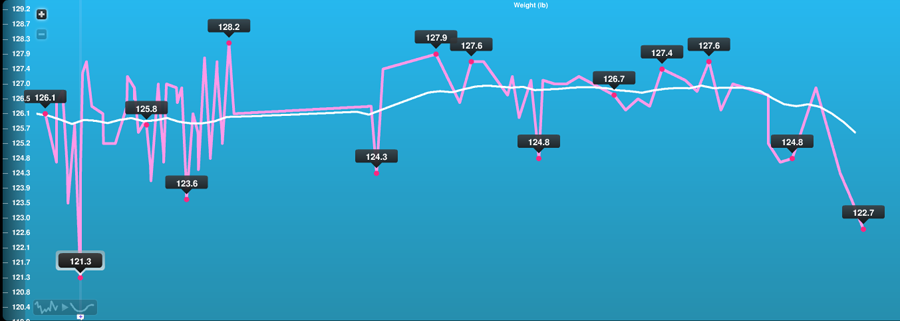Quantified year: The trials & tribulations of food tracking
Research has already shown quite convincingly that food tracking is a great tool if you’re trying to shed a few pounds. And it’s easy to see why. Understanding the caloric implications of something as small as an extra dollop of sour cream is illuminating, never mind how quickly the numbers can add up while dining out. Anyone who reads fitness magazines (or, you know, US Weekly) can cite at least one celebrity who follows the calories in/calories out equation, compensating for a food-related splurge with a few extra minutes in the gym. Calories as the ultimate arbiter of weight loss and gain remains to be seen (likely, they are not), but they’re certainly the easiest thing to quantify. Sort of.
I came into my own Quantified Year already in awe of the king of personal statistics, Nicholas Felton (both from a design and tracking perspective), and now that I’m almost halfway done, I just don’t know how he does it. (Actually, I do. Read about his annual reports here and all about his tracking app, Daytum, here.) Point is, food tracking as it stands today is not for the faint of heart, or the average human. It is a time-consuming, painful process that I can best liken to reporting into a parole officer. And the worst part? It’s not even accurate. With the exception of pre-packaged foods that spell out explicit nutritional information, there is no way of knowing exactly what is in the things we eat. Which is a big annoying problem if you’re attempting to break it down and track it, or find granular food sensitivities, as I have for the past six months. And while calorie counting and weight loss were not the goals of this experiment, nor are they good arbiters of overall health, it has been interesting to track those fluctuations.
So in the spirit of reporting in at the halfway point, here are the tools I’ve been using, and what I’ve learned. Caveat: As mentioned above, my goal wasn’t a number; it was a quality of life.
The Tools
There are dozens, if not thousands, of calorie and food tracking applications in the app store. During my journey into its murky depths I ran into many contenders, from The Eatery to to My Fitness Pal to MealSnap (which says it does all of the above, but I didn’t find to be entirely accurate). Of the apps that fit my granular requirements 1) must be able to quantify calories/nutritional info beyond images (so I could look at specific ingredients and find triggers) and 2) exportable data, I settled on LiveStrong. Their food database is great, and their web and mobile apps work seamlessly together and are simple to use.
For the weight tracking, I picked up a Withings Wireless Scale (see interface that includes Feb-May below), which is the hardware I’ve used and enjoyed the most on my quantified journey so far. It’s pretty addictive (see my first month of usage; stepping on and off 5 times a day just to see how time changed things) and when positioned in a convenient place, just requires 10 seconds of time to use. It’s easy to see the periods of travel, and how that effected my weight, which is really the only way (at this point, anyway) to measure food control.

Caloric intake chart, showing what went in, exercise, recommendations and the resulting net calories Livestrong
Behaviors
Portion Control
Turns out even kombucha has two “official” servings in it. And each glass of wine around 100 calories. Although none of this is particularly new or profound, tracking really made me pay attention to packaging, think before that second popover and not finish the whole plate of pasta.
Impulse Control
When you’re tracking every single thing that you eat, the opportunity cost of an extra snack becomes very high. So high, in fact, that passing up snacking simply because it’s more painful to report in becomes habit. Guiltily inputting the extra chocolate or cookie no longer feels worth it. All that to say, being forced to report back to big brother is a highly motivating way to stop impulsive eating.
Travel Makes Things Tough
I travel a lot for work; Vegas, Austin, Moscow, just to name a few recent destinations. And while I try to be disciplined while on the road, the siren songs of Texas BBQ and Vegas nightlife occasionally proved to be too strong to ignore. Which made tracking, and maintaining a healthy diet, quite challenging. See the first third of my Withings chart above for the proof.
Mindfulness
While it combines all of the above, for me, the greatest gift of my quantified journey has been the simple act of paying attention. It’s really easy to hoover a few cupcakes (or whatever happens to be lying around; at Rock Health, it’s typically cupcakes) if you’re not paying attention. But more than that, the simple act of mindfulness, that is, really paying attention and becoming a more active eater, is the most powerful change I’ve experienced to date.
My personal discovery
I Think I’m Lactose Intolerant
Although the inner foodie in me is (still) weeping, food tracking helped me identify what I assumed to be true but hadn’t confirmed: I’m developing a series intolerance to dairy. Cheese, I’ve discovered, nearly always triggers a GI-related crisis, which, is hardly ever worth it. (Except maybe when it’s a nice Manchego paired with a well-aged Barolo.)
The above has been illuminating, but even as a highly-motivated data nerd, I still have difficulty separating the signal from the noise (well, perhaps with the exception of dairy). Which all begs the question (which I plan to explore in a later post) what are the odds that tracking as it stands today has a shot in hell at crossing into the mainstream, here or internationally? Based on my experience in the past few months, we’re pretty far off.
Disagree? Have a solution you think solves the above issues? Put it in the comments, or email qs@rockhealth.org.
